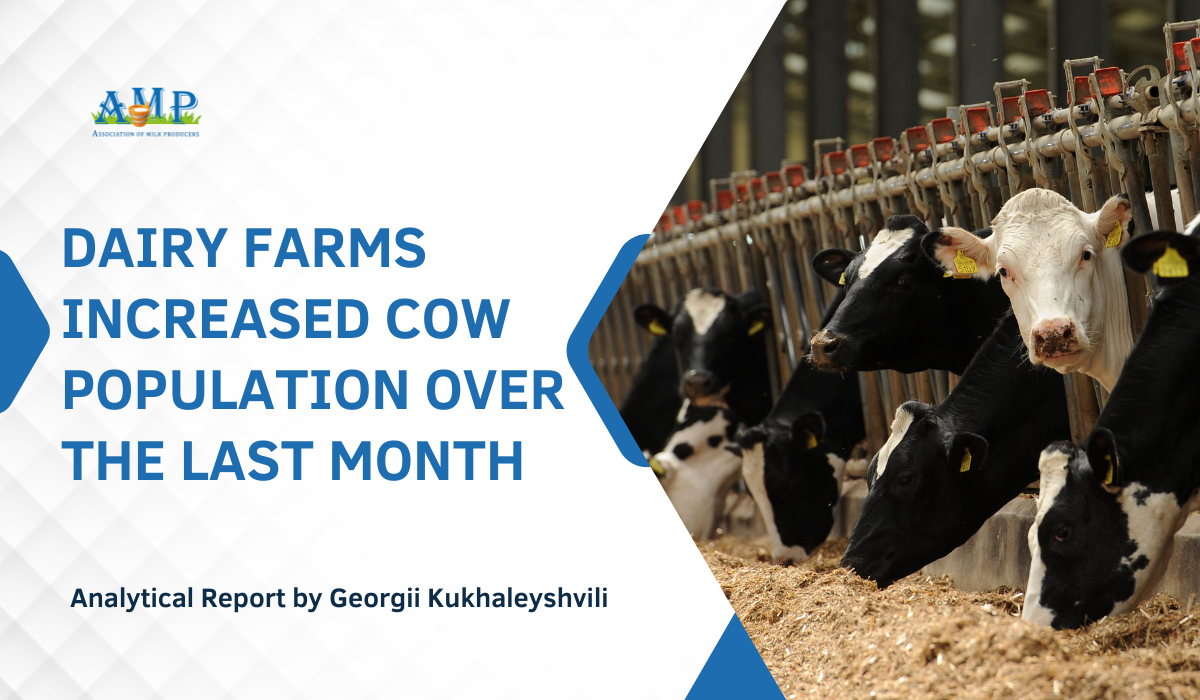In Ukraine, the number of cattle increased during March, and the rate of decline in the cow population slowed down. However, relocation processes and the potential threat of foot-and-mouth disease spreading from European countries create risks of increased culling, according to Georgii Kukhaleyishvili, an analyst at the Association of Milk Producers of Ukraine.
According to preliminary data from the Ministry of Agrarian Policy and Food of Ukraine, as of April 1, 2025, the household and industrial sectors of Ukraine held 2 million 138.4 thousand head of cattle, including 1 million 149.9 thousand cows. Compared to March 1, 2025, the cattle population in Ukraine increased by 56 thousand head (+3%), while the number of cows decreased by 200 head (-0.02%). Compared to April 1, 2024, the cattle population decreased by 178 thousand head (-8%), including cows – by 107 thousand head (-9%). About 43% of animals are kept on industrial enterprises, and 57% – in households.
In the industrial sector, 916.8 thousand head of cattle are kept, which is 1 thousand head (-0.1%) less compared to March 1, 2025. The cow population is 377.2 thousand head and increased by 500 head (+0.1%) over the last month. Over the past year, the cattle population at enterprises increased by 100 head (+0.01%), and the number of cows decreased by 1.8 thousand head (-0.5%).
In the household sector, there are 1 million 221.6 thousand head of cattle, which is 57 thousand head (+5%) more compared to March 1, 2025. The number of cows in households as of April 1, 2025, was 772.7 thousand head, which is 1 thousand head less (-0.1%) than a month ago. Over the past year, the number of cattle in households decreased by 178 thousand head (-13%), and the number of cows decreased by 106 thousand head (-12%).
Georgii Kukhaleyishvili notes that the decline in the cattle population has been ongoing in Ukraine for many years due to the lack of an effective state support program for dairy cattle breeding. The decline in the herd accelerated after the start of Russia's full-scale invasion. A typical situation for frontline regions is the death of a certain number of cattle due to shelling by Russian occupiers. Many farmers left cows in the occupied territories. These animals are not accounted for or were confiscated by the Russian occupiers and sold for meat. Farmers send injured cows for culling, which also contributes to a decrease in the herd.
Currently, there are prerequisites for the relocation of farms from the Dnipropetrovsk and Sumy Oblasts to other regions of Ukraine in the context of intensified Russian missile and bomb strikes on border and frontline settlements. Farmers will be able to transfer only part of the herd, as most farms in Ukraine were built in the 70s and 80s and no longer meet the requirements for keeping animals. The lack of suitable premises for keeping cows creates prerequisites for a further reduction in the herd.
Many farmers are not investing in increasing the cow population during the war and are experiencing a shortage of working capital. According to the study "Ukraine: the impact of the war on the profitability of agricultural production," conducted by UCAB, the Ministry of Agrarian Policy, with the support of GFDRR, farmers' production costs are growing faster than prices for finished products due to the increase in feed costs, electricity costs, the devaluation of the hryvnia, and a decrease in the purchasing power of the population.
There is cautious optimism regarding an increase in the number of commercial dairy farms in relatively safe regions of Ukraine, which, despite the war, are modernizing existing and building new facilities and increasing the number of highly productive cows. According to AMP estimates, at least 40 farms are currently implementing these measures.
According to preliminary data from the Ministry of Agrarian Policy, an increase in the number of cows in agricultural enterprises was recorded in the Ternopil Oblast (+9%), Mykolaiv Oblast (+6%), Khmelnytskyi Oblast (+5%), Lviv Oblast (+4%), Cherkasy Oblast (+3%), Poltava Oblast (+1%), and Vinnytsia Oblast (+1%) compared to April 1 of last year.
In the regional breakdown, about 55% of the total cattle population is kept in farms of all categories in the following oblasts:
- Khmelnytskyi Oblast – 195.4 thousand head;
- Poltava Oblast – 172.9 thousand head;
- Vinnytsia Oblast – 168.9 thousand head;
- Ternopil Oblast – 131.6 thousand head;
- Odesa Oblast – 131.5 thousand head;
- Cherkasy Oblast – 124.3 thousand head;
- Chernihiv Oblast – 123.2 thousand head;
- Zakarpattia Oblast – 118.2 thousand head.


